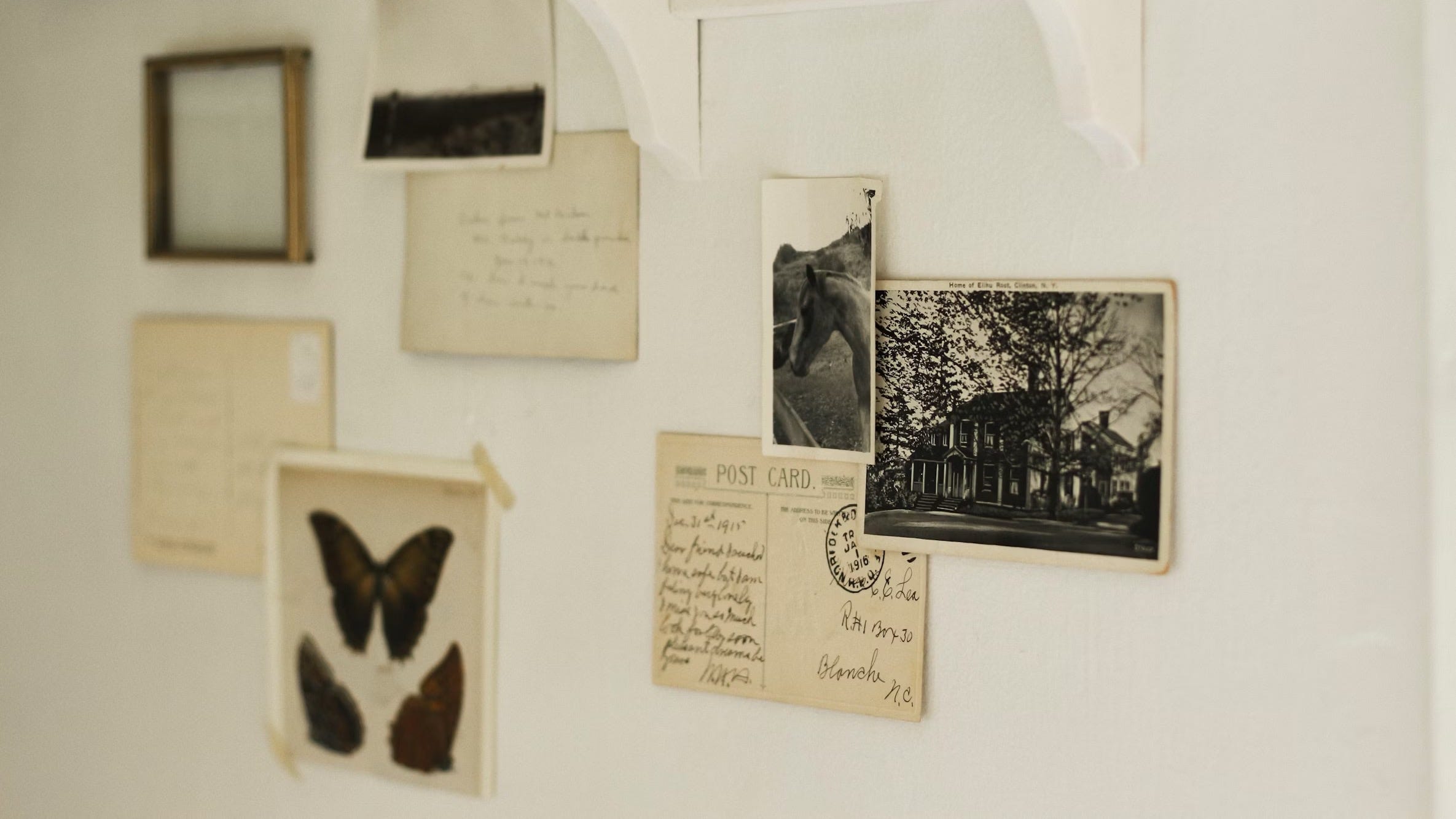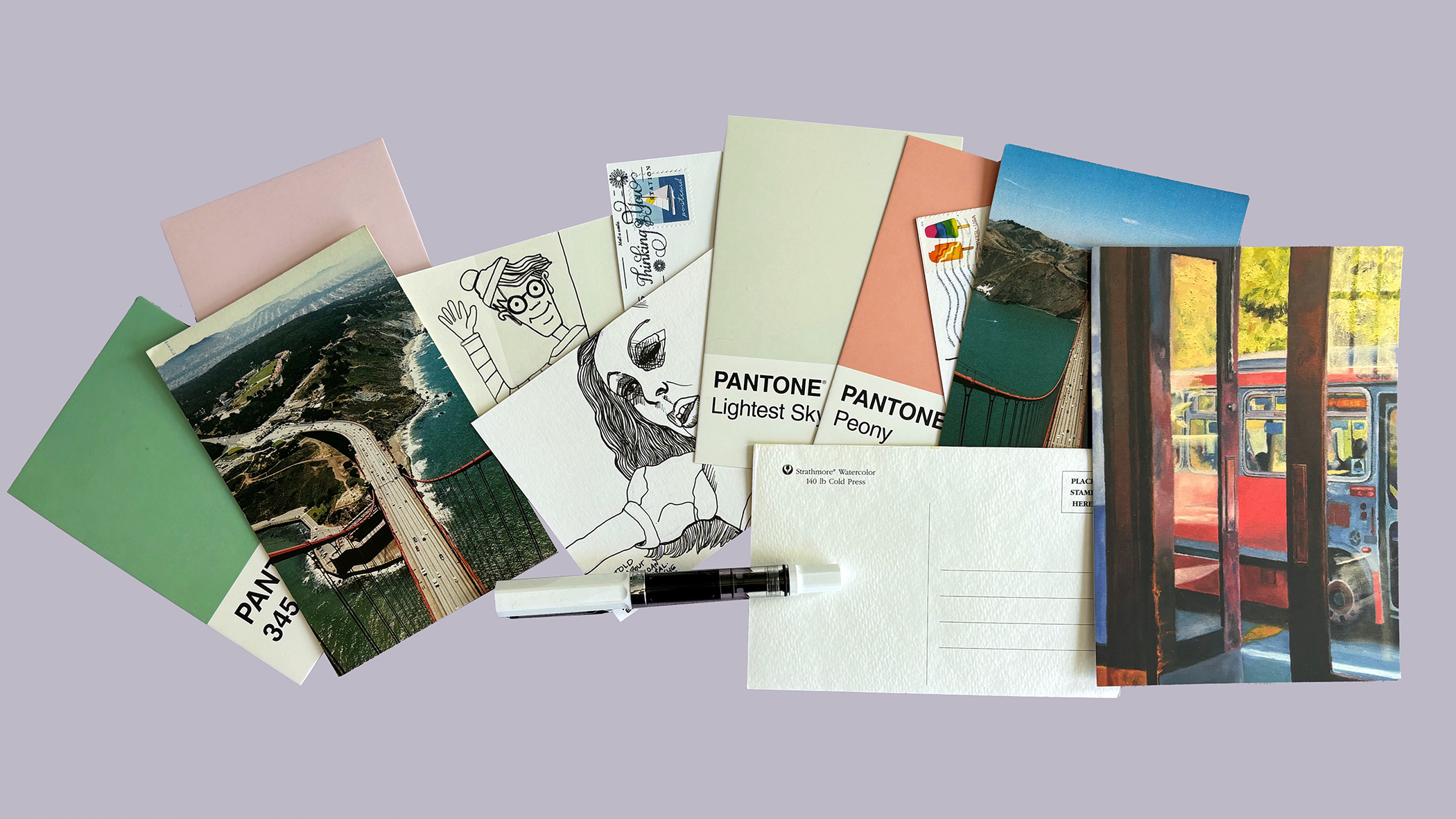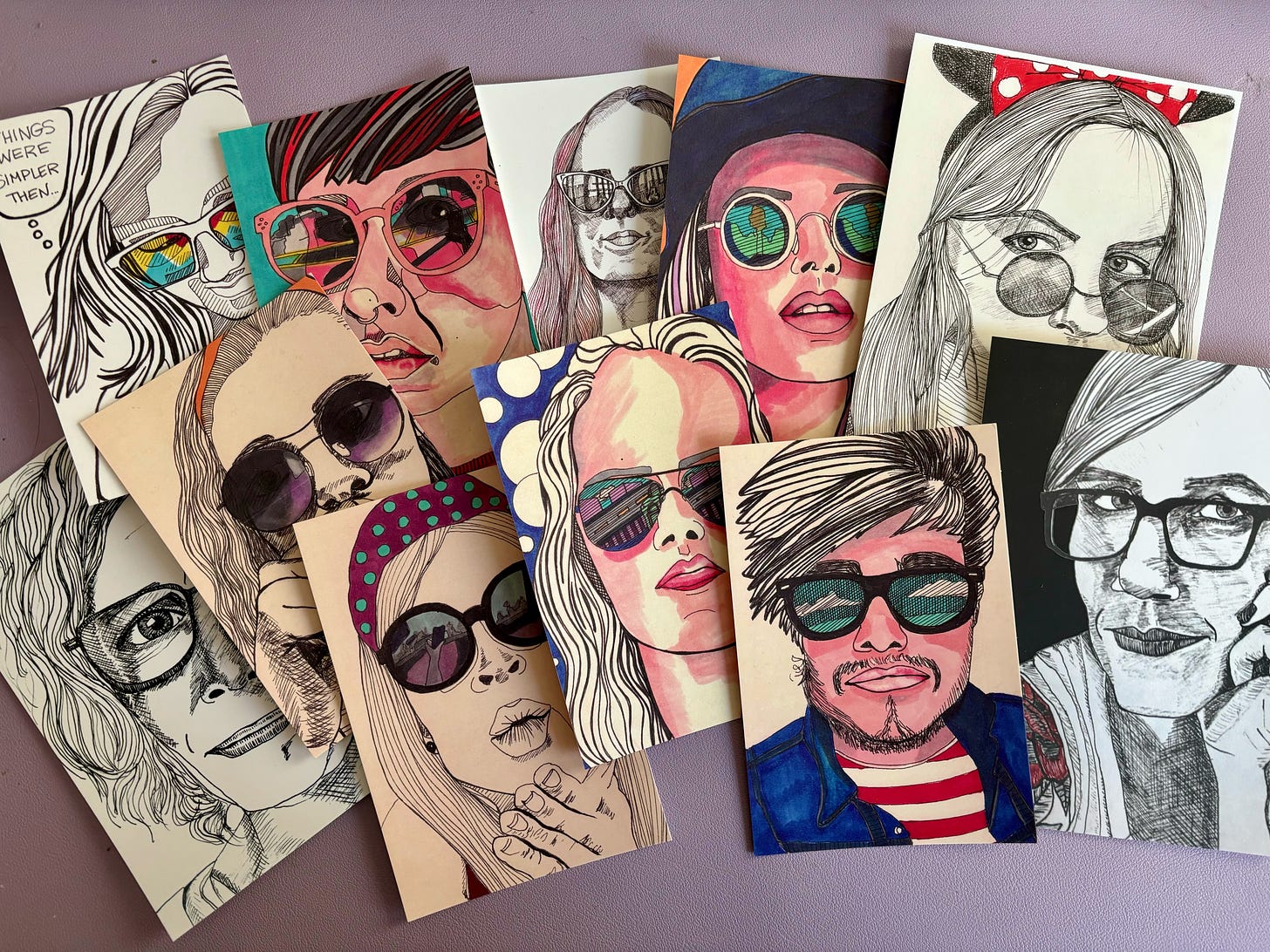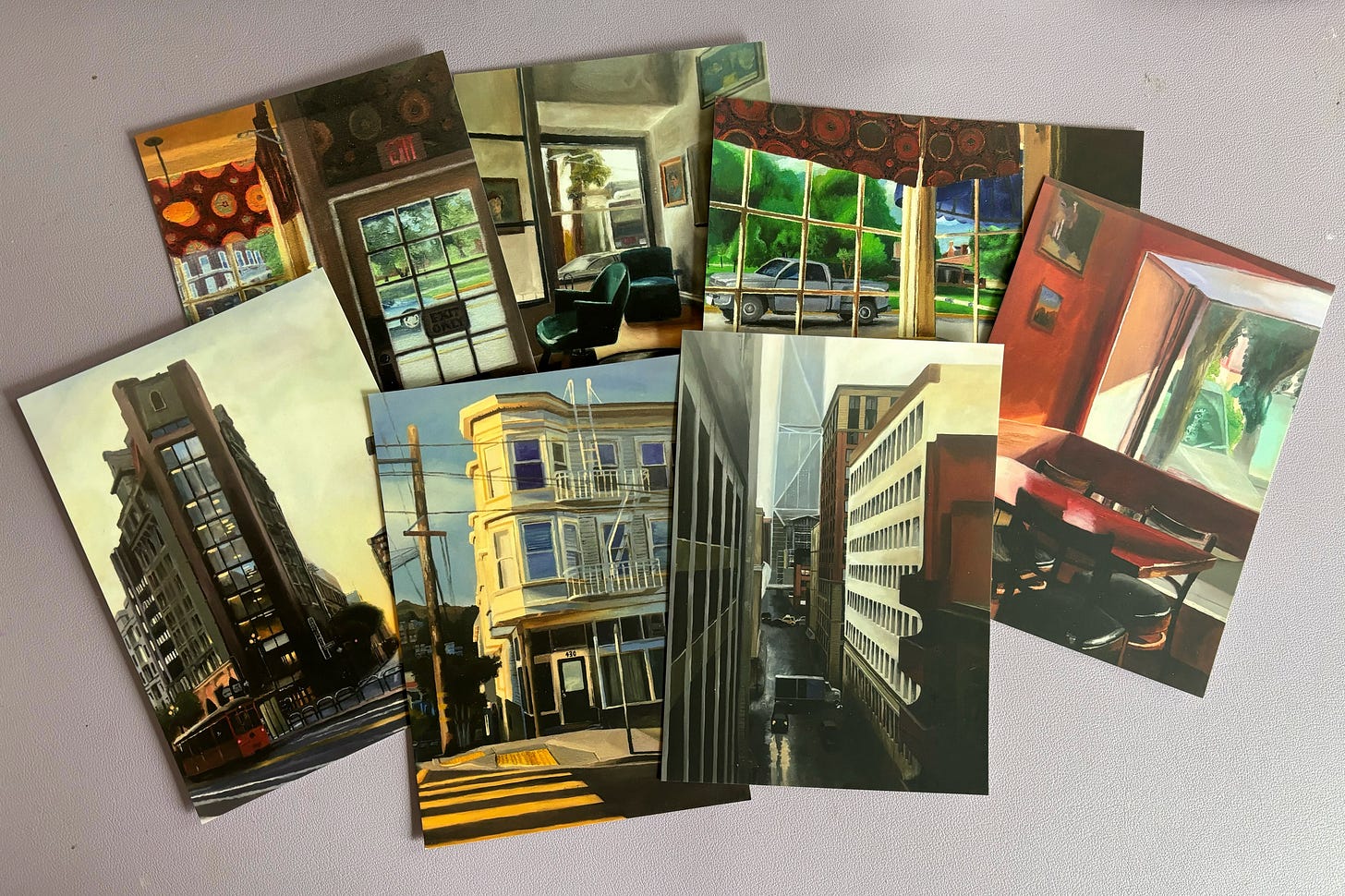A Postcard Series
Epistolary convergence and distillation, a new monthly challenge with a quietly vintage feel
Today’s letter introduces a new monthly prompt challenge and series, one that invites both written and visual art…and encourages connection.
“Any fact becomes important when it’s connected to another.” ― Umberto Eco
Happy Sunday!
I am sharing something new this week, so I am out of space before I even begin. That’s a shame because I drew a lumberjack and a rhino and a crawdad this week, and all of them felt important. The rhino really moved me. As I drew in the contours with colored pencil, I became fixated on this idea of the rhino as a heavy unicorn. I couldn’t get past the sense that that’s somehow me—a fat unicorn. (Rhinos actually have two horns. I know.)
I hinted last week that I might be starting a new challenge or a new prompt series.
I thought I was backing away a bit from the prompts scene. I decided not to post a set of Inktoportraits prompts for October this year. (I will be drawing Substack writers.)
Dropping that prompt set may sound like a little thing. Some of you will say that it’s fine, that it doesn’t matter, that it’s not a big deal, that things come and go. But it mattered to me. Part of me is still tempted to put up a prompt set simply because I hate to let things go.
As someone who tends to do her own thing, it is somewhat ironic that I’ve been sharing illustrated journal prompts for the last five years and assorted prompts in the decade before that. Mostly I create prompts I want to use. My perspective on prompts has mellowed, but I always encourage people to do projects that have personal meaning.
Someone else’s prompts can invite you to find and follow the personal, but I encourage you to look for that opening and be willing to take that leap. Don’t just draw a house because someone says the prompt for today is to draw a house. Find your own way in. Yes, I want you to have a creative habit, but I want you to build that habit with daily art that matters to you.
I always hope the prompts I share are an open-ended mix of nudge and flexibility and invitation. I hope they provide just enough scaffolding for those who want it but are also malleable enough for those who want to dive deep.
It is strange how things sometimes circle and swirl and coalesce. In recent weeks:
There were Victorian puzzle notes, an exercise in folding, mostly for the whimsy of it and for the self-reflection of finding those spaces, making those creases, and exploring the memory of paper.
There were zines, which continue to hover in the periphery, the small printouts I made still free-floating on the table.
There was a fleeting fascination with the pen pal groups.
There is a letter-focused writing series at Writing in the Dark.
There is a lost epistolary friendship, an absence that continues to knock down all the castles I build in the sand.
There is the illustrated journal, which remains my mainstay and primary creative project. It’s an everything-but-the-kitchen-sink project, which allows it to hold anything.
Into this mix of writing and drawing and documenting and remembering (or not) and reaching and connecting, I am adding postcards.
I am going to invite you to join in on drafting (and maybe sending) a series of postcards. For each of the next few months, there will be at least a monthly prompt. There may be more. Next year, this may grow into a weekly series.
You’ll find all the info below.
I hope this is a challenge some of you will join in on. This one works for the writers and the visual artists. It’s small enough that it can easily be added to your creative stack. It’s flexible. It’s vulnerable. You can write or paint or draw or collage. You can use lists or write in code or track your daily movements. But a postcard is also something specific. It’s a vehicle for reaching out to someone.
Below:
Thank you for reading.
Amy
🎯 The Sunday post is free to all readers. Thank you to those who have upgraded their subscriptions or made a donation. I believe in the value of the time we spend on our creative habits and routines.
This post contains a number of images and may be cut off in email. For the best viewing experience, use the app or view in a browser.

A Creative Postcard Challenge
When was the last time you sent a postcard? When was the last time you carried up a stack of mail and found a small card, glossy photo on one side, handwritten note on the other, tucked in among the circulars and bills? Wish you were here!
There is something unique about a postcard. It is small and compact. It may be thin, bordering on flimsy, and yet with a corner stamp in place, it is designed to make it through the system.
How many words can you fit in the split panel on the back? Do you need words? What happens to the narrative if you send drawings? Portraits? A selfie? A sketch of your morning coffee, your pet, or from your favorite cafe? What happens if you swatch your palette (ink or paint or colored pencils) each month on a postcard and mail it to someone?
What if you record thumbnails of morning light every day for a week? What happens if you write how you really feel in that blank space and send it off?
If I look out my window and draw the shape of the tree and write the colors of the sky and, later, drop it in the mail, how will you reply? If I do it once a month for a year, what will I capture? What record will the postcards hold? What will it mean to the recipient?
Intimate and Exposed
A postcard feels intimate, a whisper in the wind, and yet its intimacy is undone by the fact that its contents are not hidden. It is not concealed. It is a message that is out there for anyone to read. Saying just enough is part of the allure, part of the puzzle, part of the dance. Maybe your words are cryptic or abbreviated or written in a shorthand that will only make sense to the recipient. Or, maybe you write plainly, hold nothing back. Maybe you have nothing to hide.
An Unassuming Substrate
As a surface, a postcard is a simple and beautiful container, a glorified index card, often with a photograph or art on one side, that we intentionally compose, address, stamp, and send on a journey to connect.
Other than the annual jury duty summons, very little real or important mail arrives as a postcard. Postcards, for the most part, are personal. They are from or to someone you know. They have been selected with specificity.
Maybe we are somewhere special, or on vacation, and are sending a note to someone to let them know that we are thinking of them. Maybe it’s a bit of a flex, a throwback to days before social media: “Look where I am.”
Maybe we simply have to share that bridge or that view of sunset or that hillside in the mist. Maybe we are enjoying ourselves so much that the desire to send someone evidence of our adventure is irresistible. We don’t really mean to brag, but we want someone to know, someone to witness our journey.
Or maybe our postcards are more humble. Maybe we are sending words from home, a note carefully tucked into the small space and a favorite art series on the other side. Maybe we have the Pantone postcards. Maybe we’ve selected a specific color. Does it reflect our mood? The sky? The color we think of when we think of the recipient?
Will you send national monuments or falling leaves, paint brushes or sunsets or roosters or cats or photos of chairs or bridges or lighthouses or quilts or children’s book illustrations? Will you send photos of works by favorite artists (like Hopper, Matisse, Van Gogh)? Will you send photos of hot sauces or birds or rainbows, stacks of books or spine art, Studio Ghibli scenes, New Yorker covers, national parks, or coffee cups?
The art is part of the equation, and then there is the flip-side. You only have a small space in which to write (or illustrate) your note. What will you say?
Postcard Prompts
In a series of monthly prompts, we will create a set of postcards, each one responding to a simple nudge. You can use existing postcards, focusing on filling the blank side. This is the easiest approach. Or, you can use blank cards, your responses filling both sides.
Month by month, you will develop a set of postcards, a series of epistolary art. You might choose to work in the same medium or style or palette each month or work with repeated elements that help tie the cards together. Or you may view each postcard as a standalone piece, disconnected from others, and let the prompt guide your choices.
Simple and Mindful
The prompts will not be difficult.
These are prompts you may have done before. But we will do them in this monthly format together as the world changes over the next year, as our lives change, and as we process whatever we are going through, highs and lows, celebrations and milestones, personal journeys and the quest for meaning.
Who will you have in mind as you create your postcards? Will you mail them?
A Postcard from Your Journal
One of the projects that I run and that I encourage others to consider is the keeping of an illustrated journal that documents life with a combination of art and words. I use a weekly format because I particularly enjoy the ways in which taking things a week at a time allows for fluidity across a span of days. There is no pressure to finish pages or drawings every day. Instead, I work on spreads that can be built and shaped and filled in over the course of a week. It’s mindful. It’s flexible. Every Sunday, I start a new week.
Many of the postcard series prompts could easily be done in an illustrated journal or sketchbook or in the margins of a bullet journal or planner, but I hope you will consider the postcard as a format. The postcard presupposes a recipient, a reader, a viewer.
Postcard Logistics
To qualify for the postcard stamp, a postcard needs to be roughly 4x6 or smaller. The USPS lists the following specifications:
Rectangular in shape (not square)
At least 3-1/2 x 5 inches and at least 0.007 inch thick
No more than 4-1/4 x 6 inches and no more than 0.016 inches thick
If using traditional, preprinted postcards, you will want to make sure the cards meet the size requirements (or plan to use a letter stamp for oversized postcards). If you are going to DIY your postcards, you can buy readymade blank postcards (plain or watercolor), use heavyweight index cards, or cut your cards from heavy cardstock, Bristol board, or watercolor paper.
Using preprinted cards minimizes the work. You’ll be sharing a photograph or piece of art you like and your own art and/or writing on the other. This is also a great way to use up postcards you may already have.
If it’s been a really long time since you saw a postcard in person, remember that on one side, you’ll need to put the address on the right and the stamp in the upper right corner. Also, be aware that the postal bar code will be added along the bottom edge. If you write or draw in that space, just know it will most likely be obscured during the mailing process.
Postcard stamps are slightly less expensive than letter stamps, but there aren’t a lot of options. Currently, postcard stamps feature sailboat art by illustrator Libby VanderPloeg. If you have old stamps floating around that aren’t enough for current first-class mail (and aren’t Forever stamps), using them on your postcards can be a good option. Just make sure they meet or exceed the postcard stamp in value.
Slowing Down
A postcard series almost sounds quaint, other than the fact that there are thousands of people writing postcards in these days to encourage people to vote. Beyond that, sending almost anything with a stamp might feel just a bit old-fashioned.
As a creative project, thinking about a postcard series is exciting. I imagine postcards filled with lists, or data visualization (a la the Dear Data project), with drawings, portraits, quotes, poems, and more. I am hoping that we can push the envelope on this envelopeless space to create personal series that are unique, bold, quiet, honest, authentic, and visually awesome.
I hope we create postcards that, through their line and composition, through their art as much as their words, have something to say. I hope we send our postcards and reach someone.
An October Postcard
Not every postcard (or every piece of art) has to be deep or soul-baring or complicated. A lot of postcards just say something like “Wish you were here!” or “Wanted to let you know you’re on my mind.”
To kick off this postcard series, let’s focus on something that is relatively simple and can be tied to memory or not. It’s October, and Halloween will be coming around.
Your challenge for this month is to create a postcard (with a recipient in mind) and document a costume.
Maybe it is a costume that you remember from when you were a kid. Maybe it is a costume from your children’s Halloween years. Or maybe Halloween isn’t something that was ever a big deal for you, and you think about what kind of costume you might choose now or wish you had chosen then.
You don’t have to particularly like Halloween or be a dress-up person to do this prompt. I don’t, and I’m not. But I still find it interesting to think about my history with Halloween, most of which I don’t remember, and some of the characters that stand out for me from my parenting years, from comic books, and the world of cosplay.
You may want to separate the prompt from Halloween and think about the whole concept of dressing up (whether you do or don’t), the performative aspect of that, and even the ways in which dressing up can be used to flaunt or conceal. Maybe you are a fan of Chappell Roan and sometimes think about what it might be like to wear costumes like that. Maybe you loved Joaquin Phoenix’s version of the Joker. Maybe you love theater or anime. Or maybe you just have a soft spot for clever costumes, sewn at home or made from cardboard boxes.
So what will you put on a postcard?
I don’t dress up, but one of my favorite costumes that I’ve seen in the last few years, something that seems really “doable,” is Waldo (from Where’s Waldo), with his round glasses, red and white striped shirt, and striped hat with a red pompom. It’s an incredibly simple costume. It’s cute and clever. It looks like it would be fun. (The corresponding Wenda costume tends to involve a very short blue skirt. I would opt for Waldo. No question.)
I am also a fan of the Pantone color swatch costume. I love this idea even though it’s potentially an overthinker’s nightmare. What color would you choose?
Crayon. Alice. Rabbit. Harry Potter. Obi-Wan. Dorothy. The Tin Man. Banana. No. 2 Pencil.
Commemorate a costume on a postcard. You can draw your costume, or diagram it, or make a collage, or write it out in words. You might write the memory of a specific costume, a specific Halloween, or turn it into a poem. What does the costume say? Why this costume?
Have fun.
Postcards Past
Several years ago, I printed postcards of portraits. I hadn’t been drawing portraits long at that point. Even though I ended up with lots of Series 1 cards left, I printed another set of portrait postcards the following year based on a “sunglasses” series. These feel like forever ago.
Along the way, I also printed a set of postcard prints of some of my son’s high school oil paintings. These I still love to use and send.
What goes on the back of your postcards is at the heart of this challenge. How will you fill the blank space?
"Invisible threads are the strongest ties."—Friedrich Nietzsche
Weekly Bits and Pieces
Made It?
Thank you for reading. I appreciate your comments. Let me know what stands out for you, what you think after reading, or where we connect.
Tea party if you know exactly who you will send your postcards to
Ghost if you have a costume in mind; Snoopy if you don’t
Witch if Halloween is a favorite time for you
Moon if you’ll play along at least through the end of the year
Song pick for October
If you want to send postcards but don’t have a recipient, considering pairing up with someone in this community! I am wondering how many words I might really be able to get on a postcard.
Also, I tried something this week that summarized the last four months of posts in an audio format….but got some important things wrong. It was an interesting experiment. See what you think.
Thank you for reading Illustrated Life. Writers need readers, and I am grateful for every reader!
Paid options are available for those who can and want to support Illustrated Life, the podcast, and the weekly #illustrateyourweek prompt series. Subscriptions not your thing? One-time donations are always appreciated.
Note: links to Amazon in this post are affiliate links. You can find postcards at your local souvenir stands, museums, and other shops. You can find postcard making materials at your favorite art store or by scavenging paper products you already have.








You all are awesome for playing along. Here’s the “word” list to help decipher the comments!
Tea party if you know exactly who you will send your postcards to
Ghost if you have a costume in mind; Snoopy if you don’t
Witch if Halloween is a favorite time for you
Moon if you’ll play along at least through the end of the year
Song pick for October
It’s a hot bright September that still feels like high summer. I’m dreaming of a moonlit tea party: ghosts, faeries, and a mystical hare. A late witch rushing in with an armful of dried mums. I’ll be there shortly.
###
I adore post-cards. Your proposal instantly brought to mind artifacts from past lives; I can see the mailboxes, the senders. I also love series: I was thinking of a month of VOTE broadsides, but couldn’t afford the psychic energy in this perilous season. Finally, Dear Data! Sigh. I’m simultaneously inspired and daunted every time I pick it up.
But a postcard? Just one a month (for now)? And with just enough structure to focus me, without the itchy-prompty confinement of someone else’s storyline? Yes!
I’m in.